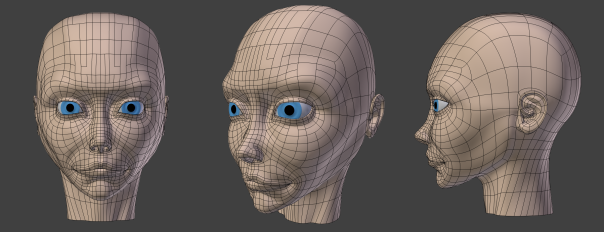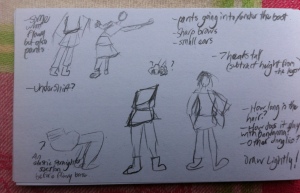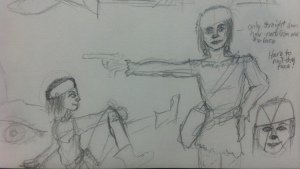So when will the movie be done?
I wanted to elaborate on what I mentioned in a previous post, that this would be a quick and dirty production. What do I mean by that? I mentioned that there is a schedule, and that implies a deadline.
When I started production (August 19th, the day this blog went live is a good date to use) I had 2 ideas for what the timeframe would be. I thought the movie could practically be done in about 2-3 months. I also knew the Blender Conference Suzanne Animation Festival submission deadline was October 16th and I wanted to try to get the movie done by then.
Since October 16th is tomorrow and the movie isn’t close to finished, that’s not possible. I had then planned to just get the first scene finished in time for the festival. I thought it would be a productive exercise to bring the first scene through the entire process and finish it before moving on to the rest of the movie, and that’s still what I intend to do, but there are still some technical issues (read on below) that need to be solved.
My thinking is that there’s about a month of work left to do on the entire movie. There are still a couple unknowns however. I want to work those out before setting an official release date. The reason I chose not to do a crunch to finish the first scene before tomorrow is there are still things I need to figure out how to do at even a basic level.
This is my first real production so the whole thing is a learning process. This doesn’t mean it can go on forever or that I’ll try to perfect everything. I’m doing this entirely on my own. I don’t want to spend a year making this. I’m not trying to make Avatar. I think that would be absurd. What I want is an understanding of what it would take to push things if I wanted to aim for that quality; an understanding of how things work in a practical sense, by getting my hands dirty for a few months making a quick little movie.
The whole idea of making a short to me is that it’s an experimental device. As opposed to a feature, there’s a controlled, small, little scope and timeframe in which to learn and play and figure out new things. That to me is the entire purpose of making a short movie. That’s my goal with this project. And the timeframe is critical to that. I don’t want to spend forever making an experimental piece; I want to move on and make bigger, feature-length films with stories that I’ve invested a lot more time in developing. This project is sort of a work out for that. And, the mandate -the script -was designed as such, to include and focus on areas I want to learn.
So it wouldn’t make sense to skip past the actual learning process because that’s the whole point. And in that respect deadlines are a little ambiguous, but also it has to be done in a controlled timeframe and provide a certain amount of pressure to get things done.
About a month ago I made a list of unsolved issues for the production:
1. Bandanna Design
2. Body +Rig
3. Animation -How long will it take?
4. Hair (Physics)/ Animation Solution
5. Cloth Simulation?
6. Expressions/ Face Rig
7. Lots of Stuff to Model
8. Volume of Characters to Model, Rig +Animate
9. Physics Effects
10. Materials/ Lighting
11. Render Time?
12. Soundtrack
There are two unknowns still for the timeframe. 1. I don’t know how long animation will or should take. 2. I don’t know how long it will take to render. Those are the big major deadline effectors. On top of that, there remains a lot of technical issues and those are potential areas where unknown unknowns can pop up unexpectedly.
Finishing the first scene will resolve all those issues, and at that point I’ll be able to set a firm deadline to release the movie. So I’m working towards that right now. Like I said, I think there’s about a month of total work left. I definitely want to try to get it done before the holidays (Thanksgiving). The process of finishing this first scene will show how feasible that is.
Now, I want to explain what I’ve been up to over the past two weeks because I haven’t made much forward progress. A couple of big re-prioritization learning experiences happened, and I want to share them with you. Here’s what happened:
First, at the end of September I finished the layout pass for the first scene and posted it online:
I also shared it on a couple forums to get some feedback. One commenter, Orinoco, on the BlenderArtists thread brought up something I had been concerned with previously myself, that the backstory of the lead character is not clear enough and that the audience might not sympathize with her. This was something I struggled with when writing the script and forgot about.
I spent some time thinking this over, thinking about the backstory, how she’s not just a thief; she’s a stow away on this ship. I thought up a more detailed explanation for what happened the night before, how she probably isn’t willing to hide out and sleep in the cargo decks or rat infested lifeboat, and is willing to risk being found just to sleep in a nicer bed. So she probably spotted this bachelor party on the way back to a room the night before, tagged along, and helped the groom to his bed where he and everyone else passed out without really knowing who she was.
I came up with some ideas about how to show this in that first scene, but none of them really explained it as well as if I just animated that scene I just described and added it on to the beginning. Although a backup idea would be to just use a title card like they do in silent movies, something like “The stow away has overslept her welcome.” I’m planning to use one or two of those later on for fun anyway so it would fit the style and would somewhat explain the situation.
As I was thinking about this though, I realized I was entirely focused on this one scene and forgetting that the end result will be the entire movie. I don’t have to explain everything in this one scene. So I decided to go back to the script and start looking at the rest of the movie to see if I could fit this information in somewhere else later on.
I quickly realized the problem I was trying to solve doesn’t really matter to the overall movie. I changed my mind, because I think when you see the situation she’s in in the following scene, you’ll sympathize with her. The backstory isn’t important. All that really matters in that first scene is that she’s a thief and has stolen this ring, which turns out to be a wedding ring. Those are the only points that need to be hit.
Furthermore, it’s a very short amount of time, so trying to add more information in that’s not actually necessary would only clutter that original intention. So I’m interested in hinting at the backstory through her outfit, the environment, the animation, but I want to leave it ambiguous for the audience to make up their own ideas.
I think it was also not clear because in the layout the groomsmen who walk into the room at the end are just stand-in characters, but in the final version they’ll have tuxes. And if that doesn’t sell that this is a wedding ring, in the next scene we cut to a ballroom with lots of establishing shots setting up a wedding reception.
To help clarify all this I’ve decided to release the first 2 complete scenes of the script: Nemusidian Cruise Ship Script First 2 Pages
The reason for dealing out pages piecemeal like this and not just releasing the entire script is that that’s part of the fun of storytelling and movie making. Saving some of that and holding it back can create a better experience for the audience, and it also helps maintain the motivation to finish it.
So, m attention and priorities were too narrowly focused on that first scene, and by extension because I had only shown that one scene, all the feedback I got didn’t incorporate the movie as a whole either. I think that was a mistake to not explain the intent of the scene clearly in context. This is useful knowledge to have because I understand now, for when I make the trailer (i.e. the first scene with a slight addendum on the end) as well as the poster and any other marketing material for social media etc. I need to setup the wedding and setup what’s coming later to put this first scene in a context.
In other words, releasing it just on it’s own without that context would be a bad idea from a storytelling standpoint.
So I re-prioritized. I stepped back and went through the whole script and cut 3 pages, which brings it down from 9mins. to about 6mins. And then I planned to storyboard the rest of the movie before I went any further. Another thing I’ve been worrying about is the number of characters to model and animate, so I also needed concept art for them.
So this was about 2 weeks ago still. I went to do concept sketches and storyboards for the rest of the movie and realized I hadn’t drawn anything in a month. I was very rusty. Not good. I spent most of the next week catching up, getting back into practice, and doing anatomy research. The topology on Nemu needed to be fixed as well, and to animate well really requires an understanding of anatomy/ how the body works. And, it helps immensely to be able to draw. So this is important.
I’ve gotten into the habit now of doing figure drawing practice about an hour every day at least. (I routinely update my sketchbook on CGSociety) So that at least is some progress.
But after a week of barely getting any actual production work done I felt I needed to switch tack again. I re-prioritized again. I decided to go ahead and proceed with the first scene before storyboarding the rest of the movie. That week also gave me more time to think over that story decision and made me more confident that it was actually the right choice.
So I got back to work with a focus on lighting and rendering, because the lighting plays an important role in the first scene I want to have a good idea how it’s going to look. And, in order to work out the lighting I need to know how I’m going to render it. And this is where I ran into the next technical issue, that I’m currently stuck on: Noise Reduction in Cycles.
Cycles is the new Blender render engine (as opposed to Blender Internal that was discontinued though still available a couple years ago). Cycles is an unbiased render engine unlike BI, which basically means it treats lights similarly to how they behave in real life. Unfortunately this method of ray-tracing creates images with a lot of granular noise unless you render a very high number of Samples to compensate. (On an even more technical note, the particular algorithm Cycles uses is very bad at interior natural lit scenes… which is ironically the exact lighting scheme I want for this first scene) Rendering more things takes more time, and it becomes very impractical for an animation when a scene takes an hour to render per frame.
Here’s a test at 1000 samples with still quite a bit of noise (Note: All the modeling is unfinished):
So I need to find a way to get render times down.
I’m considering all options at this point and I’ve spent the past few days exhausting all sorts of resources I can find, tricks on how to light things, how to render things, technical compositing tricks etc. Nothing I’ve found so far has helped that much without badly degrading the quality of the image. I’ve looked into other render engines like Yafray and Luxrender but those options aren’t very good either because they’re not integrated as well with Blender’s render passes. I could use Blender Internal and just fake a lot of things. That might be easier.
The bottom line though is that I need a rendering solution that won’t be a hassle to work with. I don’t want to be fighting noise all along the way, devoting time and energy to that as opposed to animation, so I’m looking for help, advice, anywhere I can get it if you know a good solution to this problem, please let me know in the comments or get in touch with me.
So that’s where things are now. This is a quick and dirty production. I’m calling story lock. At this point the story needs to be set if it wasn’t already and I’m only making narrow detailed changes because the focus needs to move on to these technical issues and the animation. For better or for worse I’m not going back to make big changes. Once a decision gets made and I move on to the next phase I won’t be backtracking. So there might be mistakes, and a lot of little bad things might happen, but my goal is to get the movie done in a quick and dirty manner in a controlled timeframe. That’s the point of making this short.
Thanks for reading.
And please Like the Facebook page if you want to show your support: http://facebook.com/nemusidian
Links:
First Scene Layout
Nemusidian Cruise Ship Script First 2 Pages
Nemusidian Blender Artists Thread
Nemusidian CGSociety Thread
My Personal Sketchbook Thread
Blender
Yafray
Luxrender


























